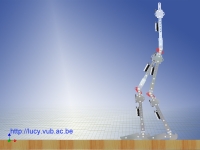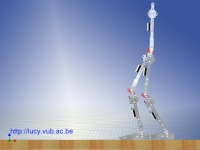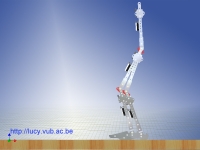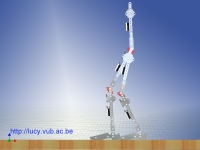Vrije Universiteit Brussel
Trajectory generationAbstractA real-time joint trajectory generation strategy for dynamically balanced legged robots is proposed. This trajectory planner generates motion patterns based on two specific concepts, being the use of objective locomotion parameters, and exploiting the natural upper body dynamics by manipulating the angular momentum equation. Using objective locomotion parameters is an elegant way of characterizing steps or hops of a motion pattern. When values for these parameters are specified, such as step length, forward speed, etc., then the trajectory planner translates these goals into feasible joint trajectories, or in other words, into actuator commands. The trajectory planner uses the angular momentum equation to ensure that the generated polynomial joint trajectories inherently guarantee a high level of dynamical postural stability for the robot. In this work, postural stability is quantified by the distance of the Zero Moment Point to the boundaries of a stability region. The upper body of the robot, with its larger mass and inertia in comparison with the leg links, manifestly affects the position of the Zero Moment Point since generally large ankle torques are required to keep it upright. In this work, the planning method defines the trajectories of the leg links in such a way that the upper body motion is naturally steered, meaning that in theory no ankle torque would be required. To overcome possible external disturbances, a polynomial reference trajectory is established for the upper body motion, which mimics a natural trajectory. Consequently the required ankle torque is low, meaning that it does not cause the Zero Moment Point to move out of the predefined stability region. Specific trajectory generation strategies are developed for two different types of robots, being a hopping monopod and a walking biped. The main difference between these strategies is that for the hopping monopod a flight phase is present, while for the walking biped a double support phase has to be taken into consideration. Both robot models are assumed to be planar systems, moving in the sagittal plane. The effectiveness of the developed planning strategies is verified by a variety of computer simulations. One of the most interesting aspects of these methods is that they are based on fast converging iteration loops, requiring a limited number of elementary calculations only. The computation time needed for generating feasible trajectories is low, which makes the strategies useful for real-time application.
Download full text of PhD dissertation: |
©2019 • Vrije Universiteit Brussel • Dept. MECH • Pleinlaan 2 • 1050 Elsene
• Tel.: +32-2-629.28.06 • Fax: +32-2-629.28.65 • webmaster



